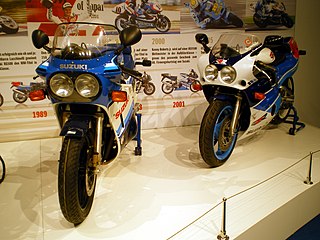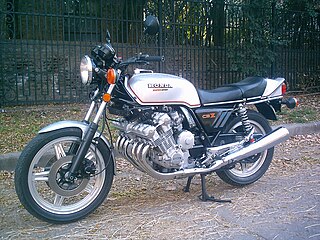
The CB Series is an extensive line of Honda motorcycles. Most CB models are road-going motorcycles for commuting and cruising. The smaller CB models are also popular for vintage motorcycle racing. The related Honda CBR series are sport bikes.

The Honda CB750 is an air-cooled, transverse, in-line-four-cylinder-engine motorcycle made by Honda over several generations for year models 1969–2008 with an upright, or standard, riding posture. It is often called the original Universal Japanese Motorcycle (UJM) and also is regarded as the first motorcycle to be called a "superbike".

Suzuki GSX-R is a series of sports motorcycles made by Japanese automotive manufacturer Suzuki since 1984.

A sports motorcycle, sports bike, or sport bike is a motorcycle designed and optimized for speed, acceleration, braking, and cornering on asphalt concrete race tracks and roads. They are mainly designed for performance at the expense of comfort, fuel economy, safety, noise reduction and storage in comparison with other motorcycles.

The Honda CBX sports motorcycle was manufactured by Honda from 1978 to 1982. With a 1047cc transverse six-cylinder engine producing 105 bhp (78 kW), it was the flagship of the Honda range. The CBX was well received by the press, but was outsold by its sibling introduced in late 1979, the Honda CB900F.

A motorcycle engine is an engine that powers a motorcycle. Motorcycle engines are typically two-stroke or four-stroke internal combustion engines, but other engine types, such as Wankels and electric motors, have been used.

In the market, there is a wide variety of types of motorcycles, each with unique characteristics and features. Models vary according to the specific needs of each user, such as standard, cruiser, touring, sports, off-road, dual-purpose, scooters, etc. Often, some hybrid types like sport touring are considered as an additional category.

The Honda CBR600RR is a 599 cc (36.6 cu in) sport bike made by Honda since 2003, part of the CBR series. The CBR600RR was marketed as Honda's top-of-the-line middleweight sport bike, succeeding the 2002 Supersport World Champion 2001–2006 CBR600F4i, which was then repositioned as the tamer, more street-oriented sport bike behind the technically more advanced and uncompromising race-replica CBR600RR. It carried the Supersport World Championship winning streak into 2003, and on through 2008, and won in 2010 and 2014.

The Suzuki Boulevard S40 is a lightweight cruiser motorcycle manufactured by the Suzuki Motor Corporation for the Japanese domestic market, and exported to New Zealand, North America, as well as to Chile and other countries.

The Suzuki GS500 is an entry-level motorcycle manufactured and marketed by the Suzuki Motor Corporation. Suzuki produced the GS500 and GS500E from 1989 on and the fully faired model, GS500F from 2004 on. The GS500 is currently being produced and sold in South America. The GS500 has been described in the motorcycle literature as a best buy and an excellent first bike, with adequate if not exciting power for more experienced riders.

The Kawasaki Z1 is a four-cylinder, air-cooled, double-overhead camshaft, carbureted, chain-drive motorcycle introduced in 1972 by Kawasaki. Following the introduction of Honda's CB750 in 1968, the Z1 helped popularize the in-line, across-the-frame four-cylinder, a format that became known as the Universal Japanese Motorcycle or UJM.

A motorcycle frame is a motorcycle's core structure. It supports the engine, provides a location for the steering and rear suspension, and supports the rider and any passenger or luggage. Also attached to the frame are the fuel tank and battery. At the front of the frame is found the steering head tube that holds the pivoting front fork, while at the rear there is a pivot point for the swingarm suspension motion. Some motorcycles include the engine as a load-bearing stressed member; while some other bikes do not use a single frame, but instead have a front and a rear subframe attached to the engine.

The Suzuki TU250— marketed also as the TU250X, ST250 and ST250 E-Type — is a single-cylinder, air-cooled lightweight street bike manufactured by Suzuki across two generations from 1994 to 2019.
The Honda CB900F is a Honda motorcycle made in two iterations which appeared some twenty years apart. Both generations of the CB900F are straight four-cylinder four-stroke 900 cc (55 cu in) roadsters.

The Suzuki GSX-R1100 is a sport bike from Suzuki's GSX-R series of motorcycles produced from 1986 until 1998.

Craig Vetter is an American entrepreneur and motorcycle designer. His work was acknowledged when in 1999 he was inducted into the AMA Motorcycle Hall of Fame.
The Mystery Ship was a limited edition motorcycle created by Craig Vetter and released in 1980. Only 10 were built, of which seven were sold. An example is on display at the AMA Motorcycle Museum in Ohio, and another at Barber Vintage Motorsports Museum in Leeds, Al. The one on display at the Barber museum is #9 and is a Turbo charged model.
Forced induction in motorcycles is the application of forced induction to a motorcycle engine. Special automotive engineering and human factor considerations exist for the application of forced induction with motorcycles compared to other forms of motorized transportation.















